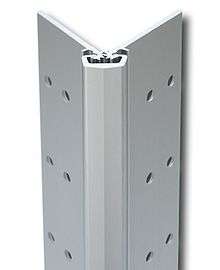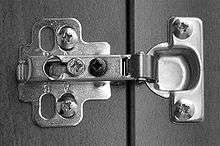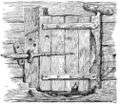Hinge
A hinge is a mechanical bearing that connects two solid objects, typically allowing only a limited angle of rotation between them. Two objects connected by an ideal hinge rotate relative to each other about a fixed axis of rotation: all other translations or rotations being prevented, and thus a hinge has one degree of freedom. Hinges may be made of flexible material or of moving components. In biology, many joints function as hinges like the elbow joint.
Door types
There are many types of door hinges. The main types include:
- Spring hinge
- a spring-loaded hinge made to provide assistance in the closing or the opening of the hinge leaves. A spring is a component of a hinge, that applies force to secure a hinge closed or keep a hinge opened.[1]
- Barrel hinge
- a sectional barrel secured by a pivot. A barrel is a component of a hinge, that has a hollow cylinder shaped section where the rotational bearing force is applied to the pivot, and may also have a screw shaped section for fastening and/or driving the pivot.
- Pivot hinges
- which pivot in openings in the floor and the top of the door frame. Also referred to as a double-acting floor hinge. This type is found in ancient dry stone buildings and rarely in old wooden buildings. These are also called haar-hung doors. They are a low cost alternative for use light weight doors.[2]
- Butt/Mortise hinges
- usually in threes or fours, which are inset (mortised) into the door and frame. Most residential hinges found in the U.S. are made of steel, although mortise hinges for exterior doors are often made of brass or stainless steel to prevent corrosion.
- Case hinges
- Case hinges are similar to a butt hinge however usually more of a decorative nature most commonly used in suitcases, briefcases and the like.

- Continuous hinges, or piano hinges
- This type of hinge is also known as a piano hinge. It runs the entire length of the door, panel, or box. Continuous hinges are manufactured with or without holes. These hinges also come in various thicknesses, pin diameters, and knuckle lengths.
- Concealed hinges
- Used for furniture doors (with or without self-closing feature, and with or without damping systems). They are made of two parts: One part is the hinge cup and the arm, the other part is the mounting plate. Also called "cup hinge", or "Euro hinge", as they were developed in Europe and use metric installation standards. Most such concealed hinges offer the advantage of full in situ adjustability for standoff distance from the cabinet face as well as pitch and roll by means of two screws on each hinge.
- Butterfly hinges, or Parliament (UK) Hinges
- These were known as dovetail hinges from the 17th century onwards and can be found on old desks and cabinets from about 1670 until the 18th century. The form of these hinges varied slightly between manufacturers, and their size ranged from the very large for heavy doors to the tiniest decorative hinge for use on jewellery boxes. Many hinges of this type were exported to America to support the home trade's limited supply. They are still found to be both fairly cheap and decorative, especially on small items.
- Flag hinges
- A flag hinge can be taken apart with a fixed pin on one leaf. Flag hinges can also swivel a full 360 degrees around the pin. Flag hinges are manufactured as a right hand and a left hand configuration.
- Strap hinges
- An early hinge and used on many kinds of interior and exterior doors and cabinets.
- H hinges
- Shaped like an H and used on flush-mounted doors. Small H hinges (3–4 in or 76–102 mm) tend to be used for cabinets hinges, while larger hinges (6–7 in or 150–180 mm) are for passage doors or closet doors.
- HL hinges
- Large HL hinges were common for passage doors, room doors and closet doors in the 17th, 18th and even 19th centuries. On taller doors H hinges were occasionally used in the middle along with the HL hinges.
Other types include:
- Counterflap hinge
- Flush hinge
- Coach hinge
- Rising Butt hinge
- Double action spring hinge
- Tee hinge
- Friction hinge
- Security hinge
- Cranked hinge or stormproof hinge
- Lift-off hinge
- Self closing hinge
Building access
Since at least medieval times there have been hinges to draw bridges for defensive purposes for fortified buildings. Hinges are used in contemporary architecture where building settlement can be expected over the life of the building. For example, the Dakin Building in Brisbane, California, was designed with its entrance ramp on a large hinge to allow settlement of the building built on piles over bay mud. This device was effective until October 2006, when it was replaced due to damage and excessive ramp slope.
Large structures
Hinges appear in large structures such as elevated freeway and railroad viaducts. These are included to reduce or eliminate the transfer of bending stresses between structural components, typically in an effort to reduce sensitivity to earthquakes. The primary reason for using a hinge, rather than a simpler device such as a slide, is to prevent the separation of adjacent components. When no bending stresses are transmitted across the hinge it is called a zero moment hinge.
Spacecraft
People have developed a variety of self-actuating, self-locking hinge designs for spacecraft deployable structures such as solar array panels, synthetic aperture radar antennas, booms, radiators, etc.[3]
Hinge terminology
Components
- Pin
- The rod that holds the leaves together, inside the knuckle.
- Knuckle
- The hollow—typically circular—portion creating the joint of the hinge through which the pin is set. The knuckles of either leaf typically alternate and interlock with the pin passing through all of them. (aka. loop, joint, node or curl)
- Leaf
- The portions (typically two) that extend laterally from the knuckle and typically revolve around the pin.
Characteristics
- End Play
- Axial movement between the leaves along the axis of the pin. This motion allows the leaves to rotate without binding and is determined by the typical distance between knuckles (knuckle gap) when both edges of the leaves are aligned.
- Gauge
- Thickness of the leaves.
- Hinge Width
- Length from the outer edge of one leaf to the outer edge of the other leaf, perpendicularly across the pin (aka open width).
- Hinge Length
- The length of the leaves parallel to the pin.
- Knuckle Length
- The typical length of an individual knuckle parallel to the pin.
- Leaf Width
- Length from the center of the pin to the outer edge of the leaf.
- Pitch
- Distance from the end of a knuckle to the same edge of its adjacent knuckle on the same leaf
- Slop
- A colloquialism referring to loose angular movement of the leaves relative to the pin.[4]
Other types
- Hinge (film)
- A short film by Aldo Emiliano Velasco (Echo) about the origin of the hinge.
- Butler tray hinge
- Fold to 90 degrees and also snap flat. They are for tables that have a tray top for serving.
- Card table hinge
- Mortised into edge of antique or reproduction card tables and allow the top to fold onto itself.
- Drop-leaf table hinge
- Mounted under the surface of a table with leaves that drop down. They are most commonly used with rule joints.
- Piano hinge
- a long hinge, originally used for piano lids, but now used in many other applications where a long hinge is needed.
- Living hinge
- a hinge consisting of material that flexes
 Old construction of hinges in the dry stone wall near Bignasco.
Old construction of hinges in the dry stone wall near Bignasco.- A flushed door hinge.
 A barrel hinge made of wrought iron.
A barrel hinge made of wrought iron. A barrel hinge made of bronze strap.
A barrel hinge made of bronze strap. Increasing the number of loops to 3 allows the butt hinge axis to be fixed from both ends.
Increasing the number of loops to 3 allows the butt hinge axis to be fixed from both ends. Door in furniture with spring to lock door both fully shut and fully open positions. It hides completely behind the door and has adjustment for fine alignment. Allows the door to open even when against a wall.
Door in furniture with spring to lock door both fully shut and fully open positions. It hides completely behind the door and has adjustment for fine alignment. Allows the door to open even when against a wall. Rusty hinges on a building exterior.
Rusty hinges on a building exterior. This door hinges on the stile and is called a haar-hung door.
This door hinges on the stile and is called a haar-hung door.- A living hinge on the lid of a Tic Tac box.
See also
References
- ↑ "Spring Hinges". Guden. Retrieved 15 December 2016.
- ↑ "Pivot Hinges". Guden. Retrieved 15 December 2016.
- ↑ Alan M. Watt; and Sergio Pellegrino. "Tape-Spring Rolling Hinges" p. 2.
- ↑ video demonstration of slop
External links
| Look up hinge in Wiktionary, the free dictionary. |
| Wikimedia Commons has media related to Hinge. |
- Hinge Terminology—Hingecraft; graphics visualizing many terms
- Guden Hinges and Industrial Hardware: Glossary